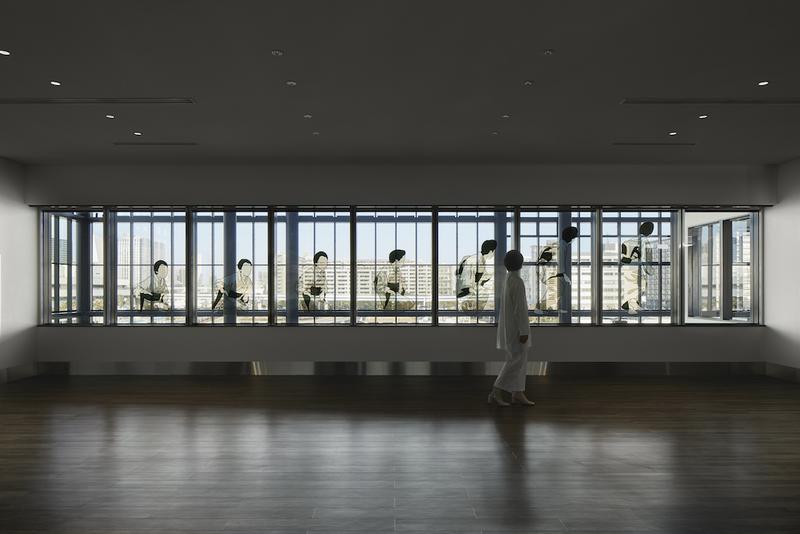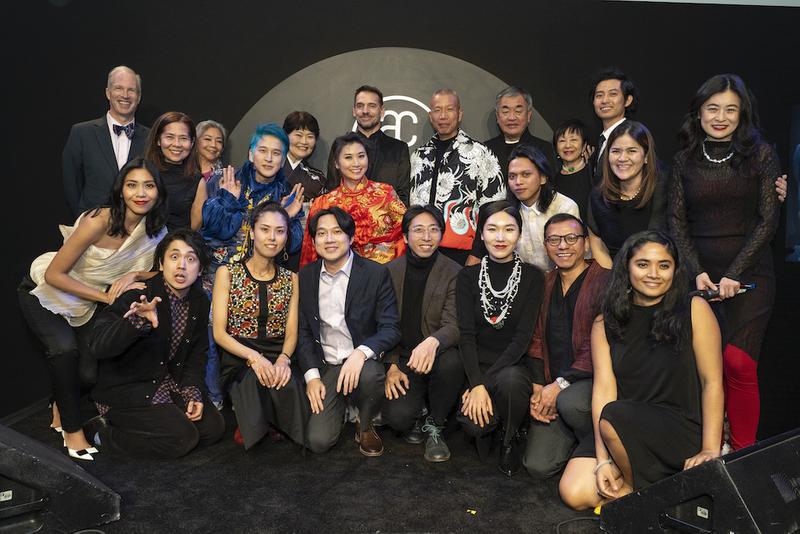Michiko Tsuda works across various media, including installation, video, and performance. Since last year, she has been working on “art for all” and “Hyogen-no-genba-chosa-dan (a team conducting surveys on art industries)” for social communication and improvement. She stayed in the U.S. for six months just before the pandemic began. Below, she reflects on her time in the U.S., her thoughts on creation and social activities.
Between Fine Art and Performing Art
For several years before I applied to ACC, I felt that the Japanese contemporary art scene was a bit distant from the dance and performing arts scene. I knew that there was a balance right in the middle where I could do exactly what I wanted to do, but I felt that there were few such opportunities in Japan.
In 2016, I started the performance duo “baby tooth” with dancer and choreographer Megumi Kamimura. In March of the following year, at the Yebisu International Festival for Art & Alternative Visions, I was shocked to see the work of dancer, choreographer, and filmmaker Yvonne Rainer. I felt it was necessary for me to deepen my understating of Rainer and her work.
I saw Rainer’s work, which was documentary-like, experimental, yet neatly made as a film, dealing with topics related to the female body: menopause, aging, and gender. It made me realize that I wanted to visit New York, one of Rainer’s bases, to get a better understanding of her work, which straddles the line between dance and film. This is what prompted me to apply to the ACC.
Traveling to the U.S. with an ACC Grant
From June to November 2019, I spent time in the United States, mostly in New York City, researching Rainer and local performing arts. I looked at performing arts documents at Lincoln Center and the New York Public Library, talked to people involved in the arts, and researched the Rainer Archive at the Getty Institute in LA. Through my research, I was able to see a performance by Rainer and fortunate enough to see its rehearsal. My Stay ended when I was trying to grasp the whole picture with a real sense of the larger context and the significance of my own quest. I am now thinking about going back to the U.S. again, and I want to continue researching about it from there.
During my stay, ACC staff told me to “cherish the experience that you can only get here.” In other words, they told me to not only pursue the result, but also to “value what I can learn just by living here.” I think this is something very unique about ACC.
So, I did my research, took dance workshops, did yoga, talked openly with various people on the street, and … I did all these things with my own rhythm. When I was open-minded, I was able to encounter many things and feel connected to everything. I no longer had to think “this is the way it has to be,” and whether it was good or not, I felt like something was unscrewed (laughs). It was a great experience.
Watching Yasujiro Ozu’s Film in New York
At the Film Forum cinema, there was a film series about downtown Tokyo. I liked Ozu’s “Tokyo Story” so much that I watched it several times. I thought that what you see in a movie changed depending on the environment in which you watch it. It was a rare experience for me to watch a film about Tokyo while surrounded by Americans.
After returning to Japan, I made use of the experience I had there, and presented a lecture-performance with Ms. Kamimura, who is my partner in our performance duo. I took the movements and gestures of the women in Ozu’s films as choreography.
For example, take the way the characters walk. Male actors such as Chishu Ryu tend to walk straight, while female actors such as Haruko Sugimura and Kuniko Miyake walk in a rather meandering manner. In addition to the role of women carrying out various household chores and providing support, it is the movement of women carrying bags, cushions, and carrying tea that contributed to the rich movement of the screen.
Making a Living is Making a Production
In the exhibition Back TOKYO Forth (at the Tokyo International Cruise Terminal in Odaiba) that started in July this year, I presented an installation called “Tokyo Shigusa.” This work also focuses on the gestures of the women in Ozu’s “Tokyo Story.”
Commodore Perry once visited Odaiba, and exactly one hundred years later, in 1953, “Tokyo Story” was shown. We know that these 100 years were turbulent times when Tokyo went from the Edo period to the rapid economic growth of the Showa era, and it was also a time when women’s housework was most difficult. By focusing on women’s gestures, I hope to connect the action to the context and imagination that moves from the past to the future.
In the past, I used to switch between creating artworks and my personal life, but now I am trying to shorten the distance between the two. My current home in Kanazawa is a hundred-year-old Japanese house, and I think that living life itself is connected to my work. I am conscious of the relationship between the history and time of my body, the place where I live, and the building, and the time and space that I realize in my work. I want to create an experience where multiple times overlap.

“Tokyo Shigusa” 2021, Installation View.
“Back TOKYO Forth,” Tokyo International Cruise Terminal, Tokyo 2021
Photo by Akira Arai(Nacása & Partners Inc.)
About the Supporters I Met in the U.S.
During my stay in New York. I attended the ACC Gala, which was attended by over 200 people. There are many donors in the U.S. who give individually, and I was very impressed to be able to talk directly with them. I was asked, “What would you like me to do?” At that time, I thought I was already helped a lot, so I felt embarrassed. Then, a realization dawned on me.
I have been involved in the arts not as a response to the demands of the worlds, but in a way that “poses questions and demands to the world.” Although I received support for my trip to the U.S., I feel that what I was able to experience in the U.S. is “a world where art exists” in a mutually interactive relationship, rather than just following the rules because I received funding. For those who support the artists, I have heard that talking to the artists and knowing what exactly they are funding is motivating and meaningful. It made me realize that I would like to be more connected to things that I thought were far away by making requests and proposals.

With ACC Grantees at ACC Gala in NY, November 2019.
About “art for all” and “Hyogen-no-genba-chosa-dan (a team conducting surveys on art industries)”
Because of this, I became involved in a networking activity called “art for all,” which was started during the pandemic, around May or June of last year.
Because those of us who are involved in the art world have not tried to connect or work with each other, there has been the situation where we have not been the target of much support. We are part of a complex world, and we feel that it is important to convey our little awareness towards others.
In last November, an activity called the “Hyogen-no-genba-chosa-dan (a team conducting surveys on art industries)” was launched, and I have been involved in it since January of this year. The project is limited to five years, and we change the subject every year. The first year is about harassment and the second year is about gender equality.
There are several ACC grantees among the members of the survey team. I think this is perhaps a result of the fact that some of them have been abroad and have an objective view of Japan and can see situations they want to improve. They are also active in many other areas beyond creating art.
Amidst a world that is said to be divided, I feel that by cherishing small insights and taking small actions, we can connect and get closer to the society around us, as well as societies far away from us. Both directly and indirectly, I would like to work with a broader perspective when creating artworks.
(Interviewed and edited by Misao Matsudaira)
Michiko Tsuda
Born in Kanagawa prefecture. Associate Professor at Kanazawa College of Art.
She completed a Doctoral Program in Film and New Media Studies at the Graduate School of Film and New Media at Tokyo University of the Arts. She performs as a unit “baby tooth” with Megumi Kamimura since 2016.
Recent group exhibitions include “Inter+Play” at Towada Art Center, Aomori (2020), “Aichi Triennale 2019: Taming Y/Our Passion” in Aichi (2019) and “Roppongi Crossing 2019: Connexions” at Mori Art Museum (2019). Solo exhibitions include “Trilogue” at TARO NASU, Tokyo (2020) and “Observing Forest” at Zarya Center for Contemporary Art, Vladivostok (2017).
Homepage: http://2da.jp/
This article is reprinted from ACC Japan Tsushin, Vol.2, September 2021.
Page 2-3. Grantee Interview.
Click here to view the September 2021 issue of ACC Japan Tsushin.
Cover Photo: Recent Portrait of Michiko Tsuda
Photo by IIKAWA Takehiro

 ACC New York
ACC New York